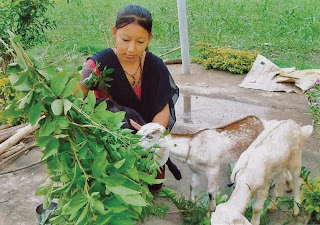On April 18, Worldwatch Institute's blog, Nourishing the Planet, published a list of 15 ways agriculture can "promote a healthier environment and a more food-secure future." In honor of Earth Day 2011, we would like to explore these 15 ways and how Heifer's projects around the world are addressing these issues. We are doing this in three separate posts, matching five Heifer projects with the corresponding Nourishing the Planet concepts. Read 1-5 here.


I come from a marginalized ethnic group in Nepal, the tharu, in which women are considered the family's honor and treasure. We are not allowed to tread outside of our houses, talk to strangers or voice our thoughts on family matters. Girls from the age of 10 are encouraged to find partners and get married. I was married at the age of 15 and bore two children by the time I was 19. My in-laws were not very well off. The family struggled to provide for every meal. All of us worked as laborers, but money was never enough. In 2006, an incident changed my life as I knew it; my husband passed away, leaving me with two children.
Having always been dependent on him for everything, I was in a state of shock for a long time. I stopped caring for my two children. What would I do with my life? The question and its unknown answers plagued my mind. My mother says I used to stare at nothing for hours. During that time, a group was being formed. Seeing this as an opportunity to engage me, my mother forced me to join. Reluctant to focus on anything except my misery, I did go to the meetings but never took part in any discussions. Slowly, the members started becoming my friends. I felt like I had someone to count on in the time of need.
My group then took the Cornerstones training -- it was like four days of continuous awakening. I felt like all my questions after my husband’s death were being answered. I was overcome with guilt for abandoning my children. Yet instead of looking ahead in life, I was burying myself in the sorrows of my past. Though fully capable of working and providing for my family, I was becoming a burden for my parents with whom my children and I lived after the death of my husband.
I now have a renewed sense of faith and belief in myself. I have my goats that I received as gifts from Heifer, and my life has found a purpose with the goats. I plan to be independent and raise my children without the shadow of poverty.
Fund a Project working with women's groups in India, Nepal or Cambodia